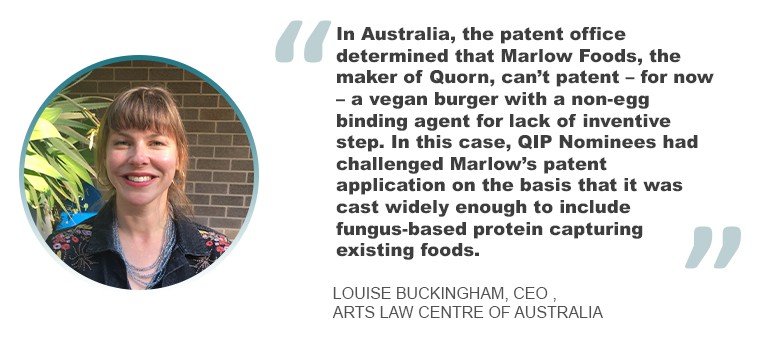Rise of plant-based meat pushes review of IP strategies
28 September 2023

The popularity of plant-based products has grown in recent years, driven by changing consumer attitudes, the adoption of flexitarian and plant-based diets, and an increase in the worldwide need for food.
Foods like tofu and tempeh have been used as meat substitutes for as long as there have been written records, and plant-based diets have long been supported for moral, ethical and health reasons. The emphasis has changed in recent decades from finding alternate protein sources to developing reliable meat replacements that appeal to a wider consumer base.
The first-generation of these “plant-based meat” substitutes, such as textured vegetable protein (TVP) and Quorn made from mycoprotein, were largely marketed to vegetarians but had trouble gaining widespread acceptance. The recent explosion of novel plant-based meat products is difficult to ignore. These products seek to appeal to a broad audience and match or even outperform traditional meat in terms of flavor and texture.
But what recent technological advancements are responsible for this quick growth, and how can companies ensure that their products stand out on store shelves among the expanding selection of plant-based options? More important, why should plant-based companies adopt a comprehensive IP strategy?
Technological innovations
According to Panisa Suwanmatajarn, a managing partner at The Legal Co. in Bangkok, to be successful in plant-based meat businesses, the meat replacement should not only look and feel like meat in the traditional way but in taste as well. It should be healthy, too.

“Technological innovations that make plant-based meat have the same functions and play significant roles in the expansion of plant-based companies,” she said. “Obviously, 3D printing, which allows for the creation of complex and customizable plant-based food products, and electrospinning, which involves using an electrical field to create nanofiber mats that can be incorporated into plant-based products to improve their texture, flavour and nutritional profile are keys to the success.”
Louise Buckingham, a former senior lawyer and head of the knowledge and innovation function at Gilbert + Tobin in Sydney, and now the CEO of the Arts Law Centre of Australia, said the technological innovations that have fueled the growth of plant-based companies include the development of products that are close to whole cuts of meat, using non-meat proteins.
“Extrusion technology, sheer-shell technology and the use of gelling an emulsifying property that are yet ‘clean’ and high-quality so that they meet consumer expectations around less-processing in terms of food production have propelled possibilities,” she explained. “With the neat values-based alignment between consumer concern for environmental, social and governance and good corporate citizenship, plant-based companies can leverage their product outputs with ethical and sustainable R&D practices and marketing and create enduring brand loyalty. They want to stand out for the quality of their offerings, ultimately, and this quality may extend literally beyond – beyond-meat, if you will – to the positive impact of the company, constructed, protected and communicated to consumers and competitors alike with the help of their IP strategy.”

Should patenting be an appropriate commercialization pathway in the particular context of the company at issue, Buckingham noted that “the more widely utilized are certain innovations, the greater will be the challenges around patentability.”
“Recently, in Australia, the patent office determined that Marlow Foods, the maker of Quorn, can’t patent – for now – a vegan burger with a non-egg binding agent for lack of inventive step,” she said. “In this case, QIP Nominees had challenged Marlow’s patent application on the basis that it was cast widely enough to include fungus-based protein capturing existing foods.”
In addition to technological innovations, Buckingham said IP strategies can help plant-based companies stand out from the crowd.”
Fueling a comprehensive IP strategy
As plant-based meat is gaining popularity, various companies are rushing into the market. Everyone is using new technologies to create plant-based meat, and more patent filings are increasing to block competitors as much as they can. Thus, a comprehensive IP strategy will come to play – patent for technological innovations, design for the visual appearance of the products and packaging, and trademark for brands, logos and trade dress.
Suwanmatajarn said to create a good comprehensive IP strategy for plant-based companies, the following inclusions should be considered:
- Conduct an intellectual property audit. This involves identifying existing IP assets and determining areas where protection is needed. The audit should also include an assessment of any potential infringement risks.
- Determine appropriate forms of IP protection. This includes patents, trademarks and designs, and will depend on the specific needs of the plant-based company.
- Work with an experienced IP attorney. Experienced attorneys specializing in the food industry can offer guidance on navigating complex patent and trademark laws and assist in crafting a robust IP strategy.
- Develop strong branding. This can help create brand recognition and value and should be protected with trademarks.
- Monitor and enforce IP rights. This helps protect the plant-based company against IP infringement and maintains competitive advantage.
- Continuously evaluate and refine the IP strategy. As the plant-based industry evolves, the IP strategy should also evolve to ensure continued protection and success.
Meanwhile, Buckingham said top legal advisers will take a whole of business approach to ensure they understand the objectives and hopes for outcomes of plant-based companies and will have deep understanding all the possibilities for IP protection and exploitation related to the products and company goals.
Every company is different and each should ensure that their adopted comprehensive IP strategy is tailored precisely to them considering their context overall. In addition to their purposes as mentioned, Buckingham added that this will include “where they’re based, operate and wish to expand, and will take into account product lines, focus for ongoing research and development. It’ll be mindful of consequent innovation and commercialization pathways, often building in flexibilities to accommodate rapid change.”
“Different types of IP – or IP ‘regimes’ – interact with each other, and with other legal and regulatory requirements in relevant jurisdictions in various ways that need to be considered in the specific instance of any strategy or strategies,” she said. “Legal market knowledge as well as understanding of markets surrounding the product and related offerings is super important.”
She continued: “Internal factors about the nature of the company, where it plans to spend its energies, and external market factors will drive considerations about utilization of what we think of as ‘traditional’ registrable forms of IP. Trademarking the company logo or brand name, patenting the underlying innovation where possible, and beyond the formula for the product – this may include innovation in packaging to preserve the product for longer, for instance. Also, potentially in this context, what we call plant breeders rights in Australia, or plant variety rights in New Zealand and the UK, or plant patents in the U.S., may come into play.”
Within this, the lifecycles of the products and other company goals must be considered to weigh up whether going down the registration route makes sense for the company. It may be that relying on confidential information or protection for trade secrets, bolstered by physical and contractual measures for protection better suits the business, for example.
Buckingham said that the commercial strategy that most suits the company to adopt as far as assigning or licensing elements of their IP comes into play. Or they may wish to retain control outright and want to focus their energies exclusively on a monitoring and enforcement approach.
“There are as many variations to include within any strategy as there are companies and it’s difficult to generalize,” she said. “Our firm has deep expertise in non-registrable forms of IP protection such as copyright, which may protect the text of the underlying recipes in the plant-based product, for example, as well as elements of the packaging, text and images. In ‘non-traditional’ forms, such as trade dress (get up), domain names and so on, our clients often benefit from learning how these forms of what we sometimes call ‘quasi-IP’ might relate to their situation, too.”
Challenges in using IP strategies
Stephanie Ning, senior managing associate at Bird & Bird in Hong Kong, said there are challenges that these companies may encounter.
“In terms of trademark, it is important to note that the same trademark may not be registrable in all jurisdictions due to different standards on the level of distinctiveness and/or descriptiveness required of a mark,” she said. “For example, ‘Beyond Meat’ is registrable in Hong Kong but its registration was refused in China because the word ‘Meat’ was regarded as misleading when used in relation to the applied for goods in Class 29 violating Article 10(7)(1) the PRC Trademark Law.”
Ning advised seeking local advice before filing the trademarks. It is also worth having an alternative trademark if the first choice does not go through. She added that another important point to note is that a registered trademark may become generic if it is commonly used as a descriptive sign in the market – such as if the word “impossible” is being used generically by third parties when referring to meat-alternatives.
To prevent this from happening, the registered trademark symbol, ®, should always be in use together with the trademark, Ning said. If there is any infringement sighting, the trademark owner should take active action.

As for patents, companies are reminded that they only gain full protection once their patent is granted. However, prior to publication of the patent application, they may be subject to risks of information of invention being disclosed to competitors. To fully protect the process of invention, Ning said that companies should sign NDA and include a confidentiality clause in the employment contract with all parties involved in the project.
“Internally, plant-based companies should make sure confidentiality clauses are included in the contract with their employees and NDA signed with other relevant parties to prevent confidential information from leaking. Externally, the companies shall register all IP rights at the earliest opportunity and actively enforce against any infringement of IP rights,” she advised.






